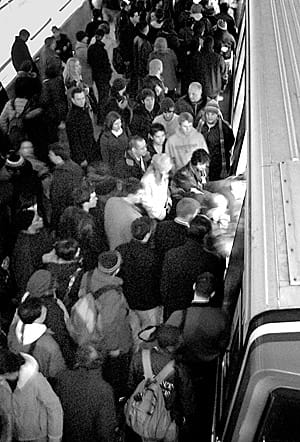11 Jan Commuting Rules of Engagement

Rush Hour on the DC Metro. Photo by andrew.deci via Flickr.
When you commute five days a week on public transportation you start to see the same people standing in the same places everyday. I’ve always marveled at how our clocks are in sync. Do each of these people get up at 5:30 a.m. like I do, eat breakfast while reading the paper, then go shower and dress for work, all at the same moment?
So it wasn’t surprising when I saw that tall man, in his late 50s, wearing his wide-brimmed leather hat and trench coat on the subway platform. He’s one of those people who not only gets on at my “home” Metro stop but also gets off at the same downtown destination I do. I see him in the morning and in the evening on our way home. Everyday. We live and work in close proximity. There are a few of us. But I’ve never talked to any of them (although I often make eye contact with a guy who brings his wife flowers every Thursday).
I’ve never engaged this man with the hat but I have been keenly aware of him from the beginning. He’s a nervous sort of guy. When the subway car stops he walks fast to the entrance and when the door opens he rushes in to get his special seat. Luckily, that special seat isn’t my special seat. In fact, I have worked hard not to rush in to get my special seat expressly because I don’t want to act like this man.
Now, you need to know a bit about human nature, specifically Washington, DC Metro commuting behavior. When a train arrives what we should do is move to the sides of the doors and let everyone out before entering. This is the civil and evolved way. But this doesn’t always happen. In fact, it rarely happens. There’s a pile up of bodies squeezing to get out and those simultaneously pushing to get on. I try hard to not succumb to this madness.
On this particular day as I waited for the jostling to begin I looked to the left and Mr. Man with the Hat was standing right next to me. I had never been this close to him before. When the doors opened as commuters started to exit the subway car he was already leaning forward in frenzied anticipation. So in play was he that it appeared he was pushing the person in front of him forward. I watched him, inches away, move in. And I could stand it no longer.
“Please stop pushing,” I said in my calmest commuter voice. “I wasn’t pushing,” he replied. “Yes you were,” I softly mumbled back. I didn’t want to cause an altercation but without thinking his statement demanded a reply, even if I was the only one to hear it. We got on –he went his way towards his pre-ordained seat and I went mine.
In order to justify my mumble I replayed our brief encounter as the train moved to the next stop. And during the playback I realized he indeed did not push the person in front of him. His body language and shuffling, like a nervous sprinter just before the gun sounds, made him appear to jostle the woman in front of him. But there was no actual contact. It was his extreme posturing that made me react.
But the deed had been done. I had revealed myself and my heretofore private evaluation of this man. I was no longer just an anonymous person he saw every day at the beginning and end of our mutual commutes. I was that man.
Sometimes it pays to keep your thoughts to yourself.
- [ Washington, DC, WMATA, Commuting, Human Nature ]




Dona
Posted at 18:13h, 11 JanuaryYou’ve captured the DC Metro commute perfectly. I don’t do it often, and avoid it when I can, but I’ve taken the Metro at rush hour.
Interesting story though — and I respect you for being so honest in your retelling.
Rob
Posted at 07:57h, 12 JanuaryGreat story, Jeff! I admire your transparency in recounting an experience that you could have more easily left untold and unknown. Many can empathize with your discomfort after the fact.
My main experience with the Métro is in Paris, France (as you can tell by the use of the accent mark.) It was interesting to note differences and similarities. One big difference is that the unwritten code in Paris is to wait until most of those exiting have done so before anyone tries to get on. I don’t know how crowded the Metro is in D.C., but in Paris it’s not for those who cannot abide having their personal space invaded! (The cliché – can of sardines – comes immediately to mind.) That could be part of the reason for the protocol I mentioned – no one could possibly get on sometimes unless someone got out. Another difference is the concept of the “special seat” – it’s a happy day if one can ever find an unoccupied seat.
One huge similarity is the almost total absence of interaction. People avoid eye contact, speaking between fellow travelers is generally in whispers if done at all, and most have some means of distraction to keep themselves isolated – a newspaper, a paperback book, an iPod, a hat to pull down over the eyes, etc.
Do you think you will try to tell your “that man” that your perceptions were off and that you spoke precipitously? Who knows, you could end up with a new friend who shares more in common with you than you’ve already noted. 🙂 Our first few exchanges were on the adversarial end of the spectrum, but we now keep in regular contact willingly and care about what’s happening in each other’s lives. Just a thought…. This story could end up with a happy sequel. 🙂
lacochran
Posted at 08:35h, 12 JanuaryI hate that people can’t seem to grasp the idea that if they let the people on the train off, then there will be more room for them! Crazy.
Okay, so he didn’t physically push but his energy was ‘pushing’.
William Lawrence
Posted at 13:25h, 12 JanuaryI like what Rob says in your comments. This post of your astute hindsight tells me that the story could develop even more with a more formal introduction to your Professor Henry Walton Jones [aka Indiana Jones].
However, I’m impressed that you remember him, you notice him, recall him, and even the others. This feat of sociological behavior is something I always wonder how many other denizens exercise. I’d be surprised if he’d remember that moment in time if’n you mentioned it to him. I believe the majority of our commuting herds don’t even remember the person they’re looking at.
Many times, I’m thankful for the faces blending into one another and becoming another blur of a day. Yet, more often than not, I want us to walk away from each day remembering at least one stranger a day, if only to remember where we are.
Keep remembering.
Jeff
Posted at 07:33h, 13 JanuaryWilliam, I am a born observer. And the Metro is like a petri dish when it comes to watching human nature unfold each day.
The man I was observing in this story was definitely not the Indiana Jones type. Jones’ character is calm and collected in the most extreme situations. My character, on the other hand, was anything but just waiting to board the train.
I’m not really interested in pursuing any kind of a further relationship with this man. The story was a study of his character (and mine, I suppose). And I don’t think our personalities would mesh.
William Lawrence
Posted at 22:13h, 13 JanuaryFor some reason I had gotten the image of him “looking like” Indiana Jones because of the wide-brimmed leather hat.
Jeff
Posted at 07:25h, 14 JanuaryThe brim was much wider than Indiana Jones’. So wide it was almost floppy. He also wore thick glasses (which, of course, made him look more studious than hero-like).